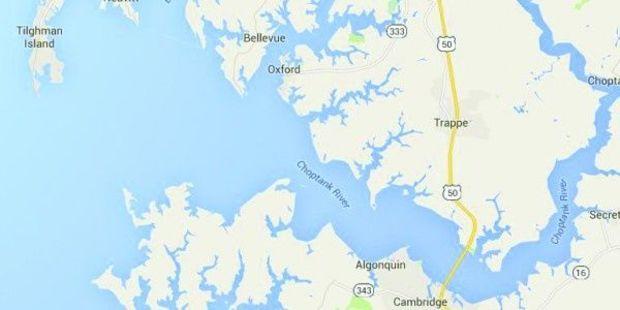In my mind’s eye I’m floating above the Choptank River, across the shoal water off Blackwalnut Point, banking a turn south toward Cook’s Point. It is mid August, the salty sweet summer air is warm and inviting. Somehow we’ve lucked into a balmy stretch of weather with the occasional gentle shower potent enough to recharge my vegetable garden. This fictional fishing trip starts a few hours before the afternoon melts into nightfall, which can be prime time for horse croakers. By mid August the Bay’s bottom fish gang—white perch, spot, croakers—can usually be caught in numbers reliable enough to fill most anglers’ creel when bottom fishing Maryland's Middle Bay. Bonus fish such as flounder, bluefish, schoolie rockfish, and even Spanish mackerel are certainly in the realm of possibilities.
Being Maryland’s longest river on the Eastern Shore—in fact it is the Chesapeake’s largest tributary on the Shore—there’s no shortage of fishing spot in the Choptank, particularly down by its mouth. I’m not sure if Maryland’s Wild and Scenic Rivers Program meant how good the river fishes when it stated “no river in the Chesapeake region has done more to shape the character and society of the Eastern Shore than the Choptank,” but it may as well have.
Linguists guess Choptank comes from the word “Chaptanck,” probably a composition of Algonquian words meaning “it flows back strongly,” referring to the river’s tidal changes. When the bite is on, the Choptank fishes strongly.
Here are some recommendations for fishing the Choptank:
The Airplane Wreck has for years been a reliable place to catch dinner. Spot, croakers (hardhead), white perch, and striped bass (aka rockfish) are common, and the abundance in some years has increased in part because of an oyster restoration site next door. A few years back, volunteers from the Dorchester Chapter of the Maryland Saltwater Sportfishermen’s Association (MSSA) and the Chesapeake Bay Foundation placed reef balls in water depths in the range of 20 to 26 feet.
South-southwest of the Airplane Wreck are twin fishing spots that on most charts are called Red Buoy and The Diamonds. The red buoy #10, a popular place to live line spot for keeper rockfish, marks to northeastern end of the locations, while the green #7 buoy serves as a boundary for the Diamonds’ most northern end. Significant changes in water depths make this a fishy spot for several species.
Last year, taking a break while black drum fishing on the Stone Rock, we meandered over to the Diamonds where we stumbled on a small school of quality resident rockfish. Trolling hoses and spoons for bluefish is also a productive method to get fish for the smoker. You can also drift for flounder here, though these days no one seems particularly interested in fishing for these tasty fish in the middle Bay. My guess is that the lack of reliable flounder numbers and striper mania are probably the chief reasons. I’ll be the first to admit that flatfishes aren’t as plentiful, and it does takes patience and skill to catch them here. But if you’re game, use live bait: spot or the biggest minnows you can find. Or cut into a tapered strip fresh bluefish belly (keep the head and tail intact), and trail it behind a 2-4 ounce bucktail, or double rig a Specialized Baits’ Lil Jimy killifish pattern, or a pre-rigged flounder rigs (Fluke Killers, Flounder Pounders, or the like). A Gulp! swimming mullet is a good choice to use as well.
For flounder fishing, forget monofilament except as leader. Your running line should be 15-20 pound test braid. It is more sensitive and has less stretch, so if you do get a flounder bite, you’ll have a better chance to feel it. When the bite is happening, The Diamonds can draw a sizable fleet of recreational anglers and charter boats from nearby Tilghman Island or from across the Bay ports such as Deale and Chesapeake Beach.
If gunwale to gunwale fishing isn’t your idea of a relaxing day on the water, you can easily strike out on your own with good chance at success, since the lower Choptank has smaller patches of live bottom nearby. Bottom fishing in the middle Chesapeake is laid back fishing, where the livin’ is easy and the fish are (usually) hungry.
Fish or Cut Bait?
For bottom fishing, a basic top-bottom rig is all you usually need. Any quality #4 or #6 sized hook does the trick. Some bottom fishermen swear by Bear Claw's Flicker snelled, long-shank hooks in gold, but you can experiment with other colors such as pearl, bronze, or fluorescent orange, green, or yellow. Long shanks make it easy to remove the hook from the small mouthed bottom species. If the bite slows during the day, you can prowl the shoreline docks, points, and shallower structure and catch to schoolie rockfish and perch using small spinners, jigs, or bait.
In past years, puppy drum were not uncommon as far north as the South River below Annapolis. Alternatives to real worms, clams, and squid have won over legions of bottom fishermen. These fake baits are easier to store since they won't expire, and economical because you can cut them into small pieces to only use what you need. Popular artificial baits include Fishbites "Bag O Worms" and Berkley products like Gulp!
by Capt. Chris D. Dollar
